If you’ve heard the term ‘bear market’ recently and thought that we’d moved beyond such animal cruelty in 2022, you’ll be relieved to know that the term has nothing to do with actual bears.
A ‘bear market’ is a phrase used in financial terminology to indicate an overall downward trend in market returns and a label used to suggest that investors are likely in trouble.
On Monday, the S&P 500, a stock market index tracking the US’ 500 largest companies, officially declared that it has been in a bear market since January of this year.
Often considered one of the most reliable measures of how the US economy is doing, the S&P 500 dropped 3.9% on Monday as the week’s trading opened. Rising interest rates in the US and investors selling their stocks in response has driven the index down by 22% since the start of the year.
The Australian sharemarket responded in kind, as it so often does, with a huge sell-off of assets. The ASX 200, the Australian stock market tracker for our own biggest 200 companies, saw a drop of more than 5% within the first hour of trading today, recovering to a drop of just 3.7%. It’s a huge loss which translates in real terms to almost $90 billion in lost shareholder value.
Mining and technology companies were hit particularly hard, with the buy-now-pay-later company Zip Pay losing almost a fifth of its value in a single day.
Cryptocurrencies have also seen steep declines in value as people sell their digital assets in order to prevent further losses.
What Is a Bear Market?
Financial markets are described as either bull or bear markets. Supposedly, this comes from the way that each animal attacks, with a bull swiping up with its horns and a bear swiping down with its paws.
A bull or bear market can be seen either in individual valuations of companies on stock exchanges or across markets as a whole. Rising valuation sees a row of green lines going upwards diagonally, indicating a bull market, while decreasing valuation leaves a row of red lines going downwards diagonally, sort of like the marks a bears claws might leave.
Being ‘bullish’ on a stock or an index means you’re confident that the value will increase. Being ‘bearish’ would mean you think prices will drop. This also reflects the attitudes of investors, as bull markets come with a sense of arrogance and aggression while bear markets indicate fear or panic.
If this all sounds a bit silly, it’s because no one is exactly sure why we use these terms. Other explanations point to the idea of bearskin 18th-century bearskin sellers who would sell skins from trappers that they had yet to receive, potentially losing out if the value increased by the time they got their goods. Some alternatively suggest the terms come from the medieval practice of bull and bear-baiting, with people gambling large sums on the survival of one or another animal.
Officially, the S&P 500 does not declare a bar market unless the value drops by 20% or more. Given we’ve now crossed that threshold, with valuation down by 22% since the start of the year, whatever the origins of the term, we are now definitively in a bear market.
Read more stories from The Latch and subscribe to our email newsletter.







